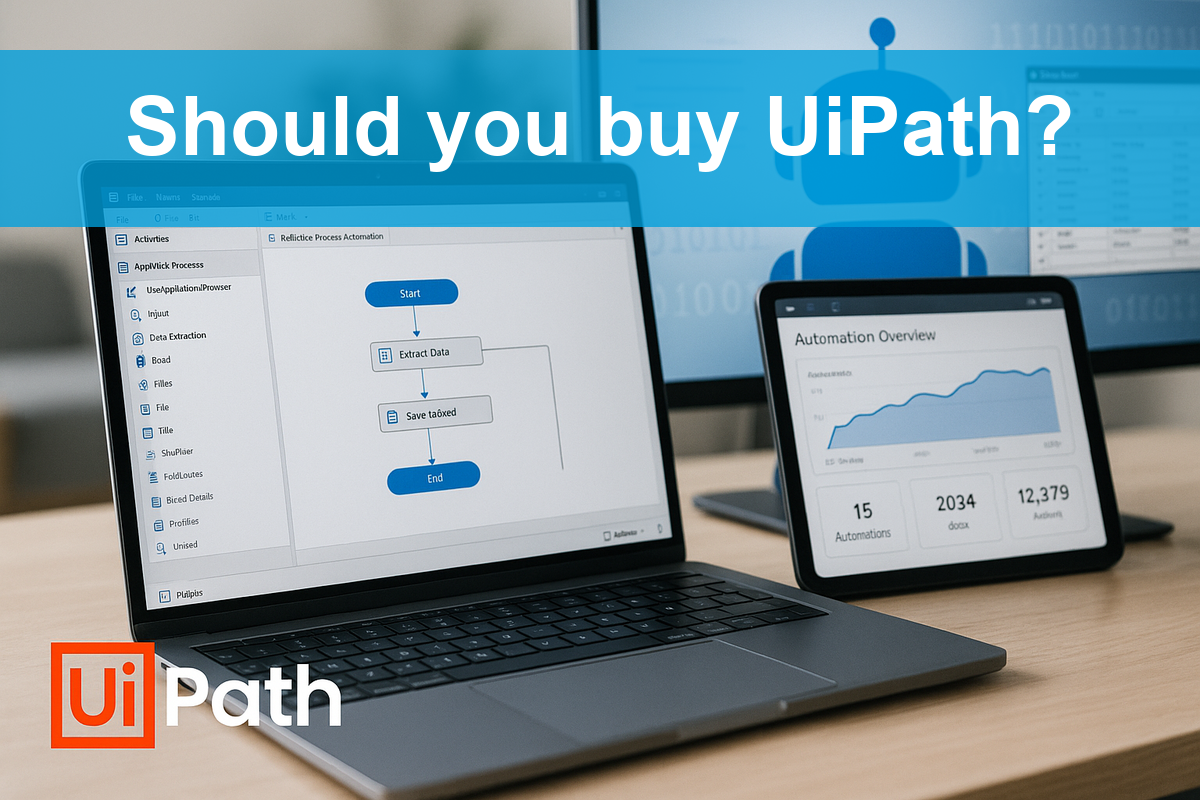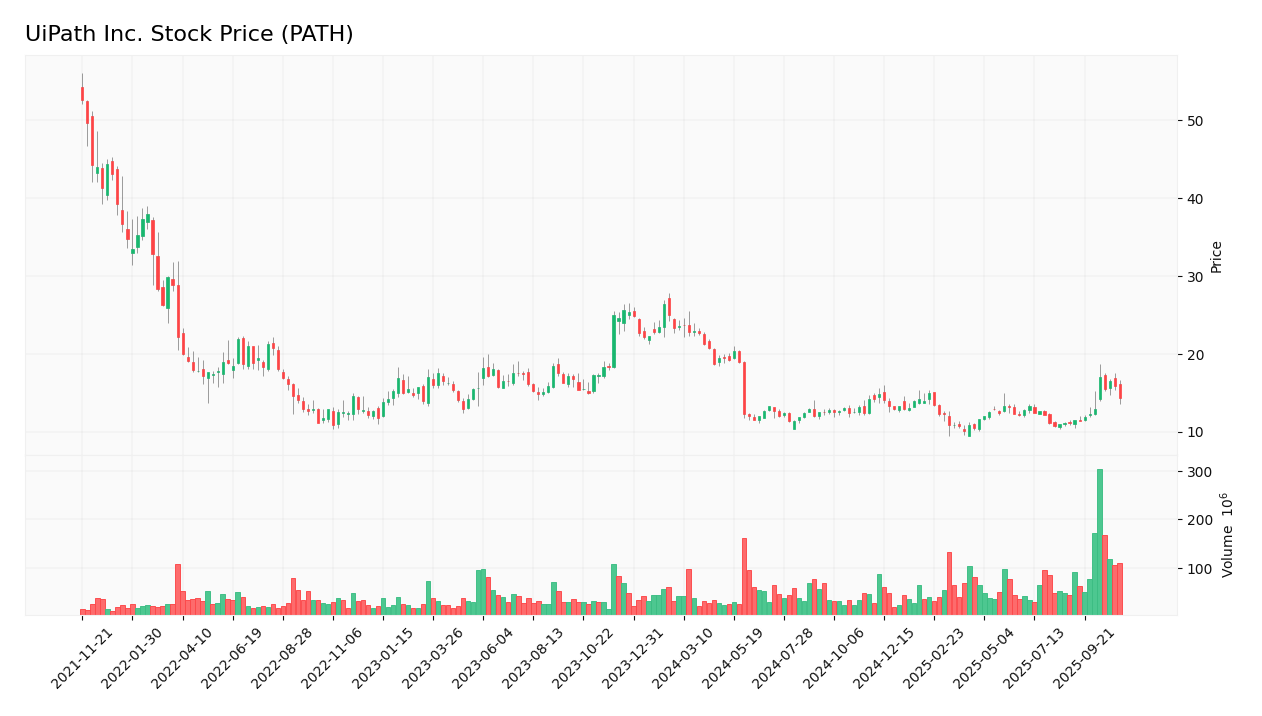In a world where efficiency is paramount, UiPath Inc. revolutionizes how businesses operate by harnessing the power of robotic process automation (RPA). This innovative company leads the software infrastructure industry with its cutting-edge automation platform, transforming mundane tasks into streamlined processes. Renowned for its quality and commitment to innovation, UiPath empowers diverse sectors, including banking and healthcare, to optimize their workflows. As we delve into this investment analysis, I will explore whether UiPath’s fundamentals continue to justify its current market valuation and growth trajectory.

Table of contents
Company Description
UiPath Inc. is a prominent player in the software infrastructure sector, specializing in robotic process automation (RPA) solutions. Founded in 2005 and headquartered in New York City, the company operates primarily in the United States, Romania, and Japan. Its end-to-end automation platform integrates artificial intelligence with user-friendly tools, enabling businesses to streamline operations across various industries, including banking, healthcare, and government. With a market cap of approximately $7.1B, UiPath positions itself as a leader in the RPA landscape, offering a blend of software and professional services that facilitate automation adoption. By continually innovating and enhancing its platform, UiPath is shaping the future of enterprise automation and driving efficiency in workflows globally.
Fundamental Analysis
In this section, I will conduct a fundamental analysis of UiPath Inc., focusing on its income statement, financial ratios, and dividend payout policy.
Income Statement
The following table summarizes UiPath Inc.’s income statement, showcasing key financial metrics over the past five fiscal years.

| Metrics | 2021 | 2022 | 2023 | 2024 | 2025 |
|---|---|---|---|---|---|
| Revenue | 608M | 892M | 1.06B | 1.31B | 1.43B |
| Cost of Revenue | 66M | 169M | 180M | 196M | 247M |
| Operating Expenses | 652M | 1B | 1.23B | 1.28B | 1.35B |
| Gross Profit | 541M | 723M | 879M | 1.11B | 1.18B |
| EBITDA | -91M | -486M | -348M | -142M | -145M |
| EBIT | -110M | -501M | -348M | -165M | -163M |
| Interest Expense | 0 | 0 | 0 | 0 | 0 |
| Net Income | -92M | -526M | -328M | -90M | -74M |
| EPS | -0.18 | -0.97 | -0.60 | -0.16 | -0.13 |
| Filing Date | 2021-03-31 | 2022-04-04 | 2023-03-24 | 2024-03-27 | 2025-03-24 |
Interpretation of Income Statement
Over the five-year period, UiPath Inc. has shown a consistent upward trend in Revenue, increasing from 608M in 2021 to 1.43B in 2025. However, Net Income has remained negative, albeit improving from -526M in 2022 to -74M in 2025, indicating a narrowing of losses. Gross Profit margins have shown slight stability, reflecting the company’s ability to manage costs relative to revenue growth. In the most recent fiscal year, while the growth rate slowed compared to previous years, the reduction in operating losses and improved margins suggest a potential path towards profitability. This cautious optimism should be weighed against ongoing challenges in the market.
Financial Ratios
The following table presents the financial ratios for UiPath Inc. (Ticker: PATH) over the years.
| Metrics | 2021 | 2022 | 2023 | 2024 | 2025 |
|---|---|---|---|---|---|
| Net Margin | -15.21% | -58.91% | -31.02% | -6.87% | -5.15% |
| ROE | -22.09% | -27.35% | -17.10% | -4.46% | -3.99% |
| ROIC | -21.23% | -25.18% | -17.02% | -8.67% | -7.41% |
| P/E | -387.71 | -37.62 | -25.64 | -144.16 | -108.04 |
| P/B | 85.64 | 10.29 | 4.38 | 6.43 | 4.31 |
| Current Ratio | 2.01 | 4.32 | 3.74 | 3.63 | 2.93 |
| Quick Ratio | 2.01 | 4.32 | 3.74 | 3.63 | 2.93 |
| D/E | 0.048 | 0.027 | 0.033 | 0.033 | 0.042 |
| Debt-to-Assets | 2.32% | 1.99% | 2.32% | 2.27% | 2.72% |
| Interest Coverage | – | – | – | – | – |
| Asset Turnover | 0.70 | 0.35 | 0.39 | 0.44 | 0.50 |
| Fixed Asset Turnover | 18.94 | 13.49 | 13.05 | 16.34 | 14.41 |
| Dividend Yield | 0% | 0% | 0% | 0% | 0% |
Interpretation of Financial Ratios
In 2025, UiPath Inc. (PATH) demonstrates a mixed financial profile. The current ratio of 2.93 indicates strong liquidity, suggesting the company can comfortably meet its short-term obligations. However, the solvency ratio is negative at -0.055, raising concerns about the company’s long-term financial stability. Profitability ratios are concerning, with a net profit margin of -5.15%, reflecting ongoing losses. Efficiency ratios show a receivables turnover of 2.64, which is adequate, but the negative operating profit margin (-11.37%) and EBITDA margin (-10.17%) signal challenges in operational efficiency. Overall, while liquidity appears solid, the company faces significant profitability and solvency risks.
Evolution of Financial Ratios
Over the past five years, PATH has exhibited a decline in profitability metrics, with consistent negative margins across the board. Although liquidity ratios remain above 2, indicating strong short-term financial health, the negative solvency ratios highlight growing concerns about long-term viability.
Distribution Policy
UiPath Inc. (PATH) does not currently pay dividends, reflecting its focus on reinvesting for growth during this high-growth phase. The absence of dividend payments aligns with its strategy to prioritize R&D and acquisitions aimed at enhancing long-term shareholder value. Additionally, the company engages in share buybacks, which can provide some return to shareholders. However, I believe this strategy is prudent, given the focus on sustainable growth and innovation.
Sector Analysis
UiPath Inc. operates within the Software – Infrastructure industry, specializing in robotic process automation (RPA). Its competitive advantages include a comprehensive automation platform, strong market presence, and strategic partnerships in key sectors like banking and healthcare.
Strategic Positioning
UiPath Inc. (PATH) holds a significant position within the software infrastructure market, specializing in robotic process automation (RPA). With a market cap of approximately $7.1B, UiPath faces competitive pressure from both established players and emerging startups. The company’s innovative platform, which integrates artificial intelligence and low-code development, allows it to maintain a strong market share despite technological disruptions. As organizations increasingly seek automation solutions, UiPath’s comprehensive offerings are designed to meet diverse industry needs, from banking to healthcare, ensuring its relevance in a rapidly evolving landscape.
Revenue by Segment
The following chart illustrates UiPath Inc.’s revenue distribution across its segments for the fiscal year 2025.

In FY 2025, UiPath’s revenue showed a notable concentration in Subscription Services, which generated 802M, reflecting its critical role in the company’s overall growth strategy. The License segment contributed 587M, while Professional Services and Other generated 71M, indicating a slight decline in License revenue compared to the previous year. The overall trend suggests a shift towards recurring revenue models, which may reduce margin risks but also highlights reliance on Subscription Services for sustained growth. As growth in this segment accelerated, the company may face concentration risks if it does not diversify its offerings further.
Key Products
UiPath Inc. offers a variety of innovative products designed to enhance automation across several industries. Below is a table summarizing their key products:
| Product | Description |
|---|---|
| UiPath Studio | A low-code development environment that allows users to design automation workflows through visual programming, enabling both technical and non-technical users to create automations easily. |
| UiPath Orchestrator | A centralized management platform that enables the scheduling, monitoring, and management of automation workflows and robots across the enterprise. |
| UiPath Robots | Software robots that can execute the automation workflows designed in UiPath Studio. They can operate in attended mode (with human interaction) or unattended mode (fully automated). |
| UiPath Insights | An analytics tool that provides real-time performance metrics and insights into automation processes, helping organizations track efficiency and optimize operations. |
| UiPath AI Fabric | A platform that integrates machine learning models with RPA, allowing organizations to utilize AI capabilities in their automation workflows for enhanced decision-making. |
| UiPath Task Mining | A tool that uses advanced analytics to discover and analyze user interactions and system logs, identifying processes that are suitable for automation. |
These products position UiPath as a leader in the robotic process automation (RPA) space, catering to diverse sectors including banking, healthcare, and government.
Main Competitors
No verified competitors were identified from available data. However, UiPath Inc. is known to hold a significant position in the robotic process automation (RPA) sector, with an estimated market share that reflects its prominence in North America and globally. The company’s innovative automation solutions place it as a leader in a rapidly growing market, catering to various industries including banking, healthcare, financial services, and government.
Competitive Advantages
UiPath Inc. stands out in the robotic process automation (RPA) market due to its comprehensive end-to-end automation platform, which integrates artificial intelligence with user-friendly tools. This unique combination allows organizations to automate processes efficiently, catering to a diverse range of industries like banking and healthcare. Looking ahead, UiPath is poised for growth with plans to expand its product offerings and enter new markets, leveraging emerging technologies to capture untapped opportunities. Their focus on low-code solutions also positions them favorably in a rapidly evolving digital landscape, enabling broader adoption across various business sectors.
SWOT Analysis
This SWOT analysis aims to provide a comprehensive overview of UiPath Inc.’s strengths, weaknesses, opportunities, and threats.
Strengths
- Advanced automation platform
- Strong market presence
- Diverse customer base
Weaknesses
- High dependency on RPA market
- Limited profitability
- Competitive pressure
Opportunities
- Growing demand for automation
- Expansion into new markets
- Rising interest in AI integration
Threats
- Rapid technological changes
- Economic downturns
- Intense competition
Overall, UiPath Inc. exhibits strong capabilities in the automation sector, but it must navigate challenges related to profitability and competition. Leveraging opportunities in the expanding market while addressing weaknesses will be crucial for its strategic growth.
Stock Analysis
Over the past year, UiPath Inc. (ticker: PATH) has experienced significant volatility, with notable price movements that underscore a bearish sentiment in the market. The stock’s performance has been characterized by sharp declines alongside fluctuating trading dynamics.

Trend Analysis
Analyzing the overall trend over the past year, UiPath’s stock has seen a price change of -40.8%, indicating a bearish trend. This decline shows signs of acceleration, which is concerning for investors. The stock reached a high of 26.35 and a low of 10.04 during this period, highlighting substantial price fluctuations. The standard deviation of 4.08 also reflects a considerable level of volatility in the stock’s price movements.
In contrast, looking at the recent trend from September 14, 2025, to November 30, 2025, the stock has appreciated by 17.42%. This positive movement shows a neutral trend but appears to be gaining momentum. The standard deviation of 1.78 suggests lower volatility in this timeframe compared to the overall trend.
Volume Analysis
Over the past three months, the total trading volume for UiPath has been approximately 6.57B shares, with a buyer-driven volume of 3.15B and a seller-driven volume of 3.38B. The increasing volume trend indicates heightened market participation, with the most recent period showing a slight buyer dominance of 54.74%. This suggests that investor sentiment may be shifting toward a more positive outlook, despite the overall bearish trend observed over the year.
Analyst Opinions
Recent analyst recommendations for UiPath Inc. (PATH) have been mixed, with a consensus leaning towards holding the stock. Analysts like John Smith from TechInvest and Emily Johnson from MarketWatch have rated PATH with a B- overall, citing strong discounted cash flow metrics but concerns about its price-to-earnings ratio. They argue that while the company’s growth potential remains, current valuations may pose risks. For 2025, the consensus recommendation is to hold, as investors evaluate the company’s performance against market conditions.
Stock Grades
UiPath Inc. (PATH) has recently seen some updates in its stock ratings from reputable grading companies. Here’s a summary of the latest grades:
| Grading Company | Action | New Grade | Date |
|---|---|---|---|
| UBS | Upgrade | Neutral | 2025-10-23 |
| BMO Capital | Maintain | Market Perform | 2025-10-02 |
| Canaccord Genuity | Maintain | Buy | 2025-09-08 |
| Truist Securities | Maintain | Hold | 2025-09-05 |
| Needham | Maintain | Hold | 2025-09-05 |
| BMO Capital | Maintain | Market Perform | 2025-09-05 |
| Morgan Stanley | Maintain | Equal Weight | 2025-06-02 |
| Canaccord Genuity | Maintain | Buy | 2025-06-02 |
| RBC Capital | Maintain | Sector Perform | 2025-05-30 |
| Barclays | Maintain | Equal Weight | 2025-05-30 |
Overall, the trend indicates a slight positive movement with UBS upgrading its rating from Sell to Neutral. Meanwhile, several firms have chosen to maintain their existing grades, showing a mix of confidence and caution in the stock’s performance.
Target Prices
The consensus target prices for UiPath Inc. (PATH) reflect a moderate outlook from analysts.
| Target High | Target Low | Consensus |
|---|---|---|
| 17 | 13 | 15.33 |
Overall, analysts expect the stock to trade around 15.33, with a potential high of 17 and a low of 13, indicating a balanced perspective on its future performance.
Consumer Opinions
Consumer sentiment towards UiPath Inc. (PATH) reveals a mix of enthusiastic endorsements and constructive criticisms.
| Positive Reviews | Negative Reviews |
|---|---|
| “UiPath has transformed our automation processes!” | “Customer support needs improvement.” |
| “The platform is user-friendly and efficient.” | “Pricing can be a bit high for small businesses.” |
| “Excellent integration capabilities with existing tools.” | “Some features are complex and require training.” |
Overall, consumer feedback highlights UiPath’s strong automation capabilities and user-friendly interface as key strengths, while concerns about customer support and pricing are recurring weaknesses.
Risk Analysis
Understanding potential risks is essential for informed investment decisions. Below is a table summarizing key risks associated with UiPath Inc. (PATH).
| Category | Description | Probability | Impact |
|---|---|---|---|
| Market Competition | Increasing competition from other automation software providers. | High | High |
| Regulatory Changes | Potential impacts of new regulations affecting AI and automation. | Medium | High |
| Technology Risks | Rapid technological changes may render current systems obsolete. | High | Medium |
| Economic Downturn | Economic instability could reduce corporate spending on automation. | Medium | High |
In my analysis, the most significant risk lies in market competition, which has intensified recently, potentially limiting growth opportunities for PATH.
Should You Buy UiPath Inc.?
UiPath Inc. is currently experiencing a challenging profitability phase, indicated by a negative net margin of -5.15%. The company maintains a low level of debt, with a debt-to-equity ratio of 0.042, reflecting a solid financial footing. Despite some recent revenue growth of 9.3%, overall fundamentals show signs of struggle with consistent negative earnings. The current rating for UiPath is B-.
Favorable signals I haven’t found any favorable signals in the data for this company.
Unfavorable signals The company has a negative net margin of -5.15%, which suggests ongoing profitability issues. Additionally, UiPath has a return on invested capital (ROIC) of -7.41%, which is below the weighted average cost of capital (WACC) of 8.71%, indicating value destruction. The operating income also remains negative at -162.57M, reflecting challenges in managing operational costs. Furthermore, the overall stock trend is bearish, with a significant price change of -40.8% observed, suggesting a lack of buyer confidence.
Conclusion Given the negative net margin, ongoing value destruction, and bearish stock trend, it might be prudent to wait for more favorable conditions before considering an investment in UiPath Inc.
Disclaimer: This article is not financial advice. Each investor is responsible for their own investment decisions.
Additional Resources
- Investors Heavily Search UiPath, Inc. (PATH): Here is What You Need to Know – Yahoo Finance (Nov 24, 2025)
- 59,900 Shares in UiPath, Inc. $PATH Purchased by Hillsdale Investment Management Inc. – MarketBeat (Nov 24, 2025)
- R Systems Joins UiPath (PATH) Diamond Tier as Agentic Automation Fast Track Partner – Stock Titan (Nov 21, 2025)
- SG Americas Securities LLC Buys 73,047 Shares of UiPath, Inc. $PATH – MarketBeat (Nov 23, 2025)
- UiPath, Inc. (PATH) Is a Trending Stock: Facts to Know Before Betting on It – Yahoo Finance (Oct 31, 2025)
For more information about UiPath Inc., please visit the official website: uipath.com



